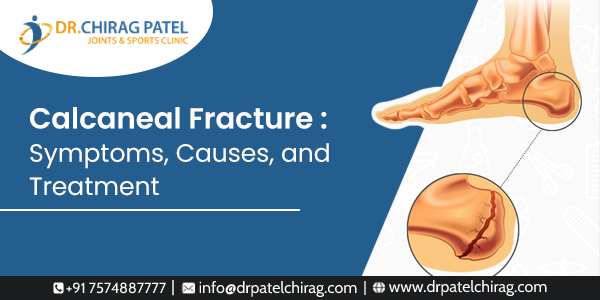A calcaneal fracture is a fracture that can occur on the calcaneus or the heel bone due to a traumatic event. Though uncommon, it can cause a lot of pain and other complications like arthritis and loss of motion. Thus, it is necessary to consult a joint specialist on time.
There are two types of calcaneal fractures. The first type involves the joints thus the damage is done to the cartilage and is the most severe calcaneal fracture. The second type does not involve the joint and usually results in multiple fractures. It also involves stress fractures.
Causes of Calcaneal Fracture
This fracture can either be caused due to traumatic injury or a stress fracture. Mostly it is caused due to trauma like falling from a great height, twisted ankle, or a vehicle accident where the foot can get crushed against the floorboard. Rarely calcaneal fractures can also occur due to stress fractures like overuse or constant stress on the heel bone.
Symptoms of Calcaneal Fracture
Different types of calcaneal fractures have different symptoms based on their location, size, and type of fracture.
Symptoms of a traumatic calcaneal fracture are:
- Inability to bear weight on the injured foot or limping.
- Sudden pain and swelling in the calcaneus.
- Bruised heel and ankle.
- Heel deformity.
Symptoms of stress calcaneal fracture are:
- Swelling in heel
- General pain in the heal accumulated slowly over a couple of weeks
Treatment of Fracture
The treatment of calcaneal fracture can include both surgical and non-surgical treatments. The type of treatment is based on the extent of the injury and its location.
Some non-surgical methods include:
- RICE: RICE stands for Rest – avoiding putting pressure on the injured foot, Ice – to help reduce swelling and pain, Compression – using an elastic bandage or sock to tie the injured area and prevent movement, and Elevation – to keep the injured foot above the heart level to prevent swelling.
- Immobilization: Casting helps immobilize the injured foot and prevent any unnecessary movement until the injury heals. Whereas, crutches help maintain balance and help avoid weight-bearing.
The surgical method is used for major and severe cases of calcaneal fractures. The surgery involves reconstructing the heel anatomy to restore movement. There are two kinds of surgeries suggested in case of such fracture. These are:
- Percutaneous screw fixation: In case of mild trauma, the pieces of the broken bone are large enough that they can be held together with the help of screws. Thus, small incisions are made to insert these special screws.
- Open reduction and internal fixation: In this method, a large incision is made to correct and align the displaced bones. The bones are then held together using metal plates, and screws until the bone recovers.
Final Overview
Dr. Chirag Patel is a trained orthopedic surgeon in Mumbai who specializes in joint replacement, sports injuries, and trauma/fractures. He performs highly specialized surgeries like Hip Resurfacing, Joint Replacement, and Computer Assisted Uni-Condylar knee replacement. Contact Dr. Patel for any problems related to hip and knee, sports injuries, and fractures.





